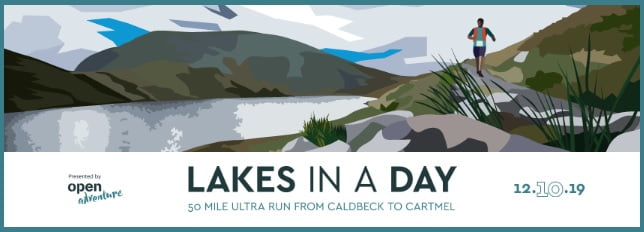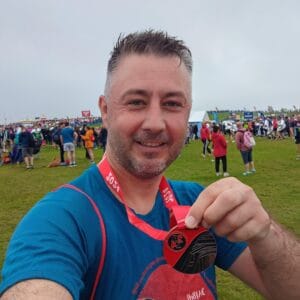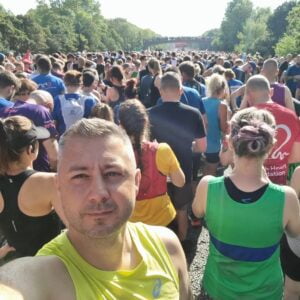Exciting times!
So, two (or more) firsts contained in this blog post:
- I cycled the Ride London 100 miles with around 25,000 other cyclists in torrential rain and horrible headwinds!
- I cycled hundreds of training miles plus the Ride London 100 using a DIY Artificial Pancreas System (Android APS) – known as a hybrid closed-loop.
Training for the Ride London 100
I’m a very casual cyclist, not in a cycling club and don’t go out with any groups of cyclists, so for my first cycling sportive to be the Ride London 100 mile was quite a leap. My training consisted of cycling the 34 mile round trip to work at least once or twice a week with a 40 – 55 mile “long” ride at the weekend, all done solo.
Living in Yorkshire I’m sure you’d expect that I’ve been climbing all those fantastic hills Yorkshire has to offer, eh? Well, no, I live in a part of Yorkshire known as the Vale of York and it is well and truly flat! Like…. really flat!! My 34 mile cycle commute includes a grand total of around 150 metres of elevation. This did not lend itself well training for a Ride London route that includes the infamous Newlands Corner climb, Leith Hill and Box Hill, famed for its inclusion in the London 2012 Olympics road race.

Us Brits love to talk about the weather, right? Well, during training it was hot, hot, hot! I coped pretty well with the hot weather and just made sure I was well hydrated and took on enough carbs to fuel myself and keep my blood glucose levels in range. Wouldn’t it be great if we had glorious weather for Ride London 100…… yeah, Ride London was wet, soggy, cold, and windswept (bring sunscreen and shades they said!).
Ride London 100 – Preparation
I’m fortunate that one of my old university housemates, good friend and multiple Iron Man triathlete, Michael lives just a few miles from the Ride London start-line. This meant I could treat my wife Katy and our eldest, George (now 5), to a trip to London for the weekend and a stay at Michael’s (Michael was taking part in the 46 mile route as part of PruGOals programme.

Staying at Michael’s meant I wasn’t rushing around prior to the event and I could prepare all my diabetes related stuff comfortably. Plus, Michael’s partner is Italian and she cooked us an amazing pasta meal the evening before the ride, bonus! Onto the equipment and ride……
The Equipment:
- Android Smartphone with “Android APS” app installed
- Accu-chek Combo insulin pump (compatible with Android APS)
- Dexcom G5 continuous glucose monitor (CGM)
- Garmin Fenix 3 Sports Smartwatch (connected via Bluetooth to my phone)

Ride London 100 – The Ride
The day started off pretty well, although very early as I was in one of the earlier starting waves, alarm set for 5am! My day started with an “in-range” blood glucose level of around 6 mmol, perfect. I’d already set my “closed-loop” system to a temporary target of 9 mmol for the duration of the ride with the temporary target to begin around 2 hours prior to my starting wave. This meant that my pump actually stopped my basal, yes that’s correct, 0% basal rate for a whole 2 hours prior to the ride!

I downed a coffee and an iced doughnut and grabbed another iced doughnut for the start line. I only bolused for around 10% of the carbs in the first doughnut knowing that too much insulin on board when out on the bike would drop my blood glucose rapidly. The first doughnut raised my blood glucose up to around the 8 – 9 mmol range and my APS “closed-loop” system responded by increasing my basal to between 50 – 100% just before the ride began, overall very little insulin on board. Immediately prior to rolling over the start line I downed the other doughnut and I was off.
The combination of 9 mmol temporary target, second doughnut and exercise worked brilliantly as my blood glucose levelled and slowly dropped to around 7 mmol. The reaction to this was for my “closed-loop” to again drop my basal rate down to between 20% and 0%.
Ride London 100 – The Carbs
I planned to eat around 40 – 60g of carbs per hour of the ride in the form of the Ride London sponsor’s Clif cereal bars, energy gels and shot bloks, trying to mix faster and slower acting carbs as and when needed to fuel me and top up my blood glucose levels. I also kept hydrated by filling my water bottles at the water stations when needed, dropping in a couple of Nuun electrolyte tablets to avoid cramping up.

My “closed-loop” system tended to increase my basal when my blood glucose approached 9 mmol and then reduced my basal as it started to drop. I didn’t bolus for the whole ride and allowed the “closed-loop” system to mop up the carbs I ate during the ride.
Overall, this strategy worked pretty well, although I did find that I took on a lot of fast acting gels rather than slower acting cereal bars. In future, as well as a temporary target of 9 mmol I’ll also do what’s called a temporary “profile switch” where I tell my “closed-loop” system to run my profile at a reduced level, probably around 50%. This would ensure that the basal rates weren’t so aggressive when my blood glucose started to climb towards the 9 mmol mark and allow me to eat fewer fast acting carbs.
Ride London – Success
Around half the ride was in torrential rain and horrendous headwinds so a distinct difference from the scorching training conditions. I spent most of the time with my rain jacket on, head down, getting a face full of tyre spray from other cyclists.
The Newlands Corner hill climb was the first major climb and I really wasn’t ready for it, freezing cold and wrong starting gear. That climb took a lot out of me and the weather made the climb my absolute toughest moment on a bike. When I got to the top of Newlands the wind was howling and the rain was like daggers. I managed to grab a few gels and cereal bars at the top of Newlands and headed on into Surrey. The mood was pretty subdued due to the weather to be honest so a lot of the first 50 – 60 miles was just plugging away on the bike.

The ride back into London from Surrey involved the two big hills, Leith Hill and Box Hill. I was more prepared for these, selected an easy gear and pretty much spun up each hill pretty confidently. The weather had started to calm down a bit too which helped and by the time I was over Box Hill the rain had stopped. The mood got better, the crowds got bigger and I felt really good, maintaining upwards of 20 mph back into London.
I finished in around 6 hrs 20 mins “moving time” (I don’t know exactly as my garmin edge cycle computer battery died at 98 miles, grrr!). Time including feed stations was 7 hrs 30 min which I was pretty happy with given the conditions and my first 100 miles, not to mention testing the “closed-loop”.
Overall, very happy and I even spotted my wife Katy and George down the finishing straight, right outside Buckingham Palace! Fantastic!

Android APS “closed-loop” artificial pancreas
I’ve been following the DIY “closed-loop” artificial pancreas scene for a long time now (at least a couple of years) and this past year there has been a major breakthrough. One of the biggest barriers to DIY closed-looping has been sourcing a pump that would work with a current DIY closed-loop system, the majority of these pumps are very old out-of-warranty Medtronics and pretty difficult to get hold of in the UK. This year the Accu-Chek Combo pump was worked on by the developers of Android APS and can now be used in a DIY closed-loop system with the addition of an app called “Ruffy” that connects the android smartphone to the combo pump. To those who worked tirelessly on this, all I can say is wow… and thanks, mega-thanks!! This is absolutely life changing.
For anyone who doesn’t know what closed-looping is, it basically involves a (compatible) CGM (Dexcom G5 for me), a closed-loop compatible insulin pump and a (compatible) smartphone running an app that is connected to both the insulin pump and CGM device.
Its really not that complicated, honest!
All of this does sound complicated but with a bit of reading and getting to understand closed looping it becomes almost as easy as using an insulin pump in its normal manner. There are safety measures built into the Android APS app, for example, spending a good amount of time “open-looping” that gets you used to manually changing basal rates that are suggested by the app. If basals aren’t quite right then run something called autotune that suggests new basal rates. It’s a case of trial and error to get the system working safely, effectively and with its intended outcomes by the time you advance to closed-looping. The in-built objectives work fantastically well at doing this. I have to add that the system is not endorsed and entirely experimental so use at your own risk.
A closed-loop system basically takes a load of factors (including insulin-on-board, carbs-on-board, current blood glucose level and loads more) then increases or reduces your basal insulin rate (within defined safety parameters) to bring your blood glucose level to a predefined target level (5.5 mmol/l for me). There’s a lot more to it than that in reality so it is worth visiting the OpenAPS pages to get a much more in-depth overview.
What next?
Next up is a trail half-marathon called “Leodis Grim” in February. I was unsuccessful in the ballot for the London Marathon (7th time), so have entered the ballot for Ride London (again) and Great North Run.
The real challenge this year is the 50 mile Lakes in a Day ultra-marathon! 50 miles with 4,000m of ascent is unchartered territory for me but I’m really looking forward to my first 50 mile ultra-marathon.






Great job! Good to see that a fellow looper can do this, I’ll be working towards the London 100 in the next couple of years, doing Paris this year.
Thanks Simon, appreciate the feedback and good luck cycling London to Paris! Keep smashing it!
Nice write up Craig. I will tap you on the shoulder if I can get hold of a Accu Chek Combo. I am being put on a 640g in two weeks as my Vibe runs out of warrenty, left me with the decision on the G5 I know and love or Enlite and auto suspend, but the later would mean having to OTG the Contour BG Meter to the phone top get it all into xDrip. Did a couple of 100k+ rides last year, mostly ate 40-60g per hour and ran Basal at -60%, having the Dex reading on my Garmin 520 really helped there, during and after.